Mining Area of the Great Copper Mountain in Falun - UNESCO ...
Mining Area of the Great Copper Mountain in Falun - UNESCO ...
Mining Area of the Great Copper Mountain in Falun - UNESCO ...
Create successful ePaper yourself
Turn your PDF publications into a flip-book with our unique Google optimized e-Paper software.
“While visit<strong>in</strong>g <strong>the</strong> town <strong>of</strong> <strong>Falun</strong> I descended 70 fathoms <strong>in</strong>to <strong>the</strong> great Swedish<br />
copper m<strong>in</strong>e so widely famed even <strong>in</strong> Ch<strong>in</strong>a.”<br />
The numerous Swedish and <strong>in</strong>ternational visitors <strong>in</strong>cluded <strong>the</strong> French Ambassador<br />
Charles d’Ogier <strong>in</strong> 1635, <strong>the</strong> English m<strong>in</strong>eralogist J.F. Leopold <strong>in</strong> 1708, <strong>the</strong> Swedish<br />
natural scientist Carl von L<strong>in</strong>né <strong>in</strong> 1734, <strong>the</strong> German <strong>the</strong>ologian Dr Christ<strong>of</strong>fer<br />
Wilhelm Lüdeke <strong>in</strong> 1783, <strong>the</strong> F<strong>in</strong>nish State Herald, J.K. L<strong>in</strong>nerhielm, <strong>in</strong> 1787 and<br />
1807, <strong>the</strong> Pomeranian author Ernst Moritz Arndt <strong>in</strong> 1804, <strong>the</strong> Danish authors H.C.<br />
Andersen and P.F. Barfood <strong>in</strong> 1849 and 1863 respectively, and <strong>the</strong> American<br />
explorer Paul B. du Chaillu <strong>in</strong> 1871. All <strong>of</strong> <strong>the</strong>m were impressed by <strong>the</strong> enormous<br />
dimensions <strong>of</strong> <strong>the</strong> copper m<strong>in</strong>e and terrified by its bottomless depths, <strong>the</strong> appall<strong>in</strong>g<br />
smoke from <strong>the</strong> roast<strong>in</strong>g houses and all <strong>the</strong> remarkable structures and devices <strong>of</strong> <strong>the</strong><br />
m<strong>in</strong><strong>in</strong>g operation. The <strong>Great</strong> <strong>Copper</strong> <strong>Mounta<strong>in</strong></strong> became Sweden’s first and biggest<br />
tourist attraction. The first recorded use <strong>of</strong> <strong>the</strong> word “tourist” <strong>in</strong> Swedish occurs <strong>in</strong> a<br />
draw<strong>in</strong>g <strong>of</strong> <strong>the</strong> m<strong>in</strong>e made <strong>in</strong> 1824.<br />
The impressions made by <strong>the</strong> m<strong>in</strong><strong>in</strong>g town can be illustrated <strong>in</strong> <strong>the</strong> words <strong>of</strong> H.C.<br />
Andersen:<br />
“Emerg<strong>in</strong>g at last from <strong>the</strong> forest we saw ahead <strong>of</strong> us a town wrea<strong>the</strong>d <strong>in</strong> thick<br />
smoke, ra<strong>the</strong>r like <strong>the</strong> English factory towns are: but here <strong>the</strong> smoke was greenish;<br />
this was <strong>the</strong> town <strong>of</strong> <strong>Falun</strong>. The road descended between a k<strong>in</strong>d <strong>of</strong> large hills, formed<br />
<strong>of</strong> <strong>the</strong> slag discarded from <strong>the</strong> blast furnaces, which resembled burnt-out, solidified<br />
lava; no vegetation was to be seen, not a blade <strong>of</strong> grass protruded by <strong>the</strong> roadside,<br />
not a bird flew past; a strong smell <strong>of</strong> sulphur, like that from <strong>the</strong> crater <strong>of</strong> Solfatara,<br />
filled <strong>the</strong> air. The copper ro<strong>of</strong> <strong>of</strong> <strong>the</strong> church was bright green with verdigris; long,<br />
straight streets opened out, silent as <strong>the</strong> grave (…) We went out to <strong>the</strong> copper m<strong>in</strong>e,<br />
for which <strong>the</strong> whole area derives its name <strong>of</strong> ‘<strong>the</strong> <strong>Great</strong> <strong>Copper</strong> <strong>Mounta<strong>in</strong></strong>’ (…) From<br />
<strong>the</strong> blast furnaces <strong>the</strong> fire shone <strong>in</strong> green, yellow and red tongues beneath a bluishgreen<br />
smoke; half-naked, grimy men were turn<strong>in</strong>g great glow<strong>in</strong>g masses <strong>of</strong> fire, so<br />
that <strong>the</strong> sparks flew round about. (…) Surrounded by smoke and permeated by<br />
smoke, build<strong>in</strong>gs stand side by side, though curiously jumbled about (…) <strong>Great</strong><br />
wheels were turn<strong>in</strong>g, long ropes and iron cha<strong>in</strong>s were <strong>in</strong> perpetual motion. And we<br />
stood <strong>in</strong> front <strong>of</strong> a great abyss, called ‘Stora Stöten’; once this was divided <strong>in</strong>to three<br />
parts, but one f<strong>in</strong>e day <strong>the</strong>y all collapsed <strong>in</strong>to one; so now this enormous declivity<br />
resembles a s<strong>in</strong>gle great valley…”<br />
The <strong>Great</strong> <strong>Copper</strong> <strong>Mounta<strong>in</strong></strong> was a lead<strong>in</strong>g centre <strong>of</strong> technical progress <strong>in</strong> earlier<br />
times. Internationally em<strong>in</strong>ent eng<strong>in</strong>eers work<strong>in</strong>g at <strong>the</strong> m<strong>in</strong>e <strong>in</strong>cluded, for example,<br />
<strong>the</strong> German Christ<strong>of</strong>fer Klem <strong>in</strong> <strong>the</strong> 16th century, Christopher Polhem, <strong>the</strong> Fa<strong>the</strong>r <strong>of</strong><br />
Swedish Mechanical Eng<strong>in</strong>eer<strong>in</strong>g, <strong>in</strong> about 1700, <strong>the</strong> Markscheider Eric Geisler and<br />
<strong>the</strong> M<strong>in</strong>eralogist Johan Gottlieb Gahn <strong>in</strong> <strong>the</strong> 18th century, <strong>the</strong> chemist Jöns Jacob<br />
Berzelius and <strong>the</strong> eng<strong>in</strong>eer Gustaf de Laval, <strong>in</strong>ventor <strong>of</strong> <strong>the</strong> separator, <strong>in</strong> <strong>the</strong> 19th<br />
century.<br />
Apart from copper, a host <strong>of</strong> o<strong>the</strong>r m<strong>in</strong>erals and bi-products have come out <strong>of</strong> <strong>the</strong><br />
<strong>Great</strong> <strong>Copper</strong> <strong>Mounta<strong>in</strong></strong>. Sulphur, z<strong>in</strong>c, lead, silver and gold became <strong>in</strong>creas<strong>in</strong>gly<br />
important dur<strong>in</strong>g <strong>the</strong> 19th and 20th centuries, as demand for copper receded. A silver<br />
furnace from 1844 is still extant, perfectly <strong>in</strong>tact. The <strong>Great</strong> <strong>Copper</strong> <strong>Mounta<strong>in</strong></strong><br />
supplies such classical Swedish products as <strong>Falun</strong> (Swedish) red pa<strong>in</strong>t - a unique red<br />
17
















